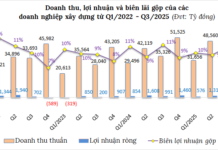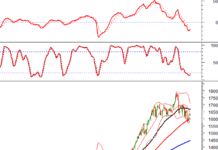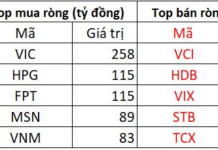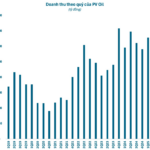This FiinRatings rating reflects the expectation that the bank’s credit profile will remain stable over the next 12-24 months. This assessment is based on several factors, including the bank’s growth advantages, improving profitability, and adequate capital and liquidity buffers relative to its operational scale. These factors align with FiinRatings‘s credit rating methodology and criteria.

Customers transacting at Nam A Bank
|
FiinRatings assesses Nam A Bank’s business position as “Adequate,” reflecting its significant improvements in scale and activity diversification in recent years, despite remaining a mid-sized private bank in Vietnam. As of June 30, 2025, the bank continued to gain market share, with total assets reaching 1.5% (ranked 17th out of 30 banks), customer deposits at 1.4% (ranked 15th/30), and loan balances at 1.3% (ranked 17th/30). The bank’s business stability is supported by key factors, including a loyal individual customer base that plays a primary role in funding. The high proportion of term deposits from this segment provides a safe capital buffer and reduces reliance on wholesale funding. The compound annual growth rate (CAGR) of customer deposits from 2020–2024 was 8.9%, and in the first half of 2025, it increased by 24.4% compared to the end of 2024, reaching a record high of 196.9 trillion VND. In terms of network, as of December 31, 2024, Nam A Bank had 148 branches/transaction offices and 125 OneBank automated transaction points nationwide, providing a stable foundation for serving key markets. Additionally, the bank’s credit policy is shifting towards essential and economically resilient sectors such as manufacturing, exports, infrastructure, and startups, thereby reducing cyclical risks. Nam A Bank is also expanding its credit chain linked to value chains and strongly growing its SME and individual customer segments through specialized credit packages, combined with “Green” and “Digital” orientations to sustain credit growth.
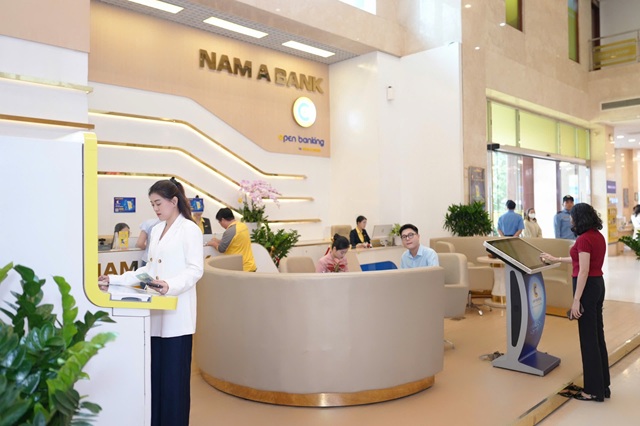
Modern transaction space with advanced technology at Nam A Bank
|
The bank’s activity diversification is rated as “Adequate,” with non-interest income accounting for 5.5% of total operating income, slightly below the industry median of 7.6% based on the latest four-quarter data as of Q2 2025. However, the bank has shown significant improvement since 2022, with non-interest income (including service income) increasing to 15% of total operating income in the first half of 2025 (full-year 2024: 12%, 2023: 13%). For the 2025–2026 period, Nam A Bank plans to expand aggressively by developing its digital service ecosystem, strengthening partnerships, and cross-selling products like insurance, investments, and financial advisory services to diversify non-credit revenue streams. The bank also aims to expand foreign exchange services, overseas remittance services, and payment services to strengthen long-term growth. However, these efforts will require more time to significantly impact the overall income structure.
FiinRatings rates Nam A Bank’s Capital Profile and Profitability as ‘Adequate,’ reflecting improvements in capital buffers, though the bank still has a higher proportion of Tier 2 capital and leverage compared to industry medians. Profitability remains stable above industry medians due to controlled funding costs, optimized credit portfolios, and enhanced operational efficiency. The bank’s Capital Adequacy Ratio (CAR) has significantly improved over the past two years, reaching 12.7% by the end of 2024 (above the industry median of 11.8%), with Tier 1 capital accounting for 65% of total eligible capital compared to the system’s 88%. The proportion of Tier 1 capital is expected to improve with the bank’s planned capital increase from 13.7 trillion VND to over 18 trillion VND in 2025, including the issuance of 343 million bonus shares to existing shareholders at a 100:25 ratio from retained earnings and 85 million ESOP shares.
Nam A Bank demonstrates better profitability than the industry average, with net interest margin (NIM) increasing from 3.1% to 3.6% between 2020–2024, compared to the industry’s rise from 2.8% to 3.3%. The bank’s return on assets (ROA) also increased from 0.7% to 1.6%, outpacing the industry’s growth from 0.7% to 1.3% over the same period. As of the first half of 2025, the bank’s NIM and ROA (based on the latest four-quarter data) were 3.3% and 1.5%, respectively, both higher than the industry medians of 3.2% and 1.4%. Effective cost control has reduced the cost-to-income ratio (CIR) from 47.6% in 2022 to 44% in 2024, with a continued downward trend in Q2 2025. FiinRatings projects the bank’s CIR to stabilize around 42-43% in 2025-2026 as digital transformation and initial investments yield results. NIM is expected to remain at 3.5-3.6%, with ROA stabilizing at 1.5%, driven by credit growth, operational optimization, and expanded non-interest income.
– 09:54 18/09/2025
“Eximbank Maintains B+ Rating with Stable Outlook from S&P Global Ratings”
The renowned international credit rating agency, S&P Global Ratings (S&P), has assigned a ‘B+’ long-term issuer credit rating with a stable outlook to the Vietnam Export Import Commercial Joint Stock Bank (Eximbank). This endorsement underscores Eximbank’s strengthened financial foundation, clear business strategy, and notable enhancements in asset quality, even amidst a volatile macroeconomic landscape.
Mrs. Tran Kieu Thuong Purchases 1 Million NAB Shares
With a recent acquisition of 1 million NAB shares, Ms. Tran Kieu Thuong now holds a substantial stake in the company. Her total ownership stands at 1.045 million shares, representing 0.061% of NAB’s capital. This significant investment showcases Ms. Thuong’s confidence in the company’s potential and underscores her active role as a key stakeholder.
The Surprising Business Turnaround of the Bank that Just ‘Changed its Name, Changed Hands’
The acquisition of GPBank and OceanBank by VPBank and MB, respectively, marked a significant turnaround for the two struggling banks. Once plagued by financial woes, these banks have now risen like a phoenix from the ashes, shedding their loss-making past and embracing a new era of profitability. This remarkable transformation is a testament to the power of strategic mergers and the expertise that VPBank and MB bring to the table.















